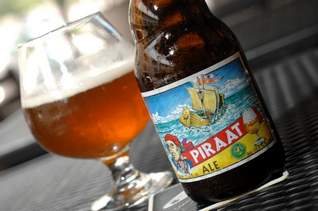Walk the plank for this Belgian IPA
For the last few hundred years, Germans brewed lagers, Brits ales and stouts, and Belgians focused on high alcohol ales fermented with spicy yeasts. These were the major brewing cultures, and any cross-pollination tinkering was considered blasphemy.
 Piraat by Van Steenberge Brewery is a Belgian IPA with a wicked 10.5 percent alcohol by volume... Hold fast!
Piraat by Van Steenberge Brewery is a Belgian IPA with a wicked 10.5 percent alcohol by volume... Hold fast!
Tasting Notes
Fast forward to the 20th century, the European beer culture remained largely static, while American craft brewers marched forward blazing new trails. Their experimental mindset led to the creation of the American Pale Ale, American IPA and American Barley Wine, more intense than their English counterparts.
Further innovation had American brewers adding unusual ingredients like coffee, fruits, and grains never used in Europe. After 20 or so years of watching American craft brewing from afar, perhaps shaking their heads in dismay, Europeans finally started taking inspiration from the U.S. around the turn of the 21st century.
One of the first American-inspired styles to hit the shores from Europe was the Belgian IPA. Tawny and opaque in appearance, this style comes with a billowy white head and often a staggering dose of alcohol. Various malts are used for the Belgian IPA, but style usually will be infused with America hops and finished with Belgian yeast.
This mud-blood approach delivers a complex sipper with a pronounced dry edge balanced with a clean, toned down finish. The Belgian IPA is not common fair in the States but worth seeking out by the beer enthusiast. Once committed to the experience, I highly recommend Piraat by Van Steenberget. This light amber ale with a full white head has the perfect interplay of malty, sweet flavors and hop bitterness. It’s a well-balanced affair but, with a 10.5 percent alcohol by volume (ABV), not for the faint of heart.
Nate Parsons is a contributor to AnnArbor.com and can be reached at modevin@yahoo.com.

